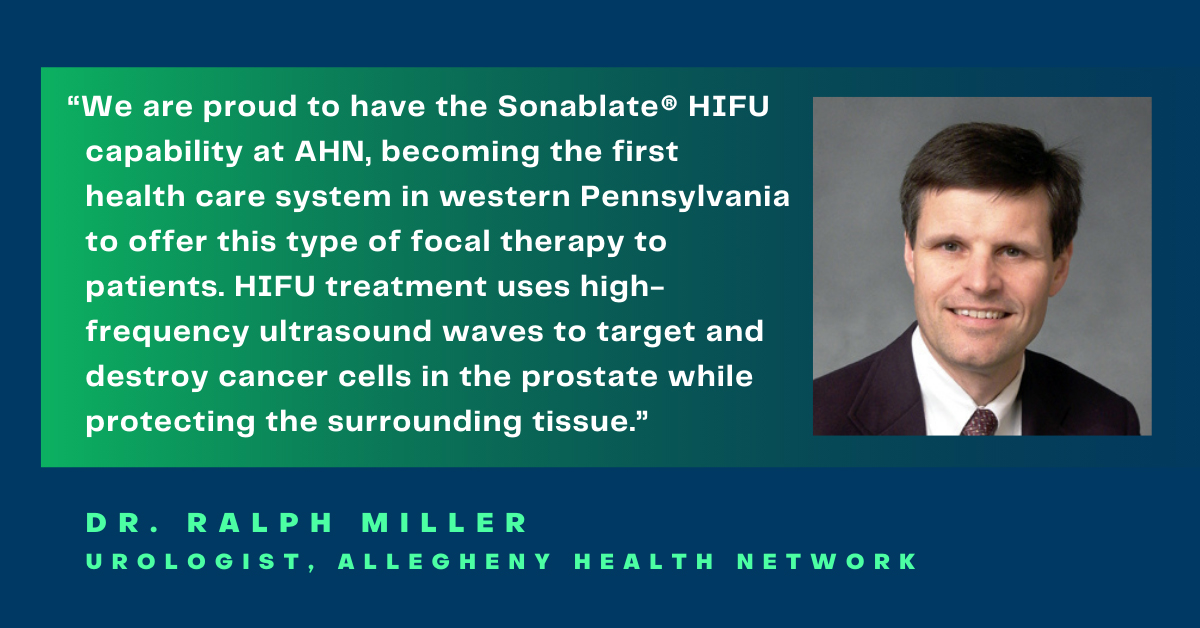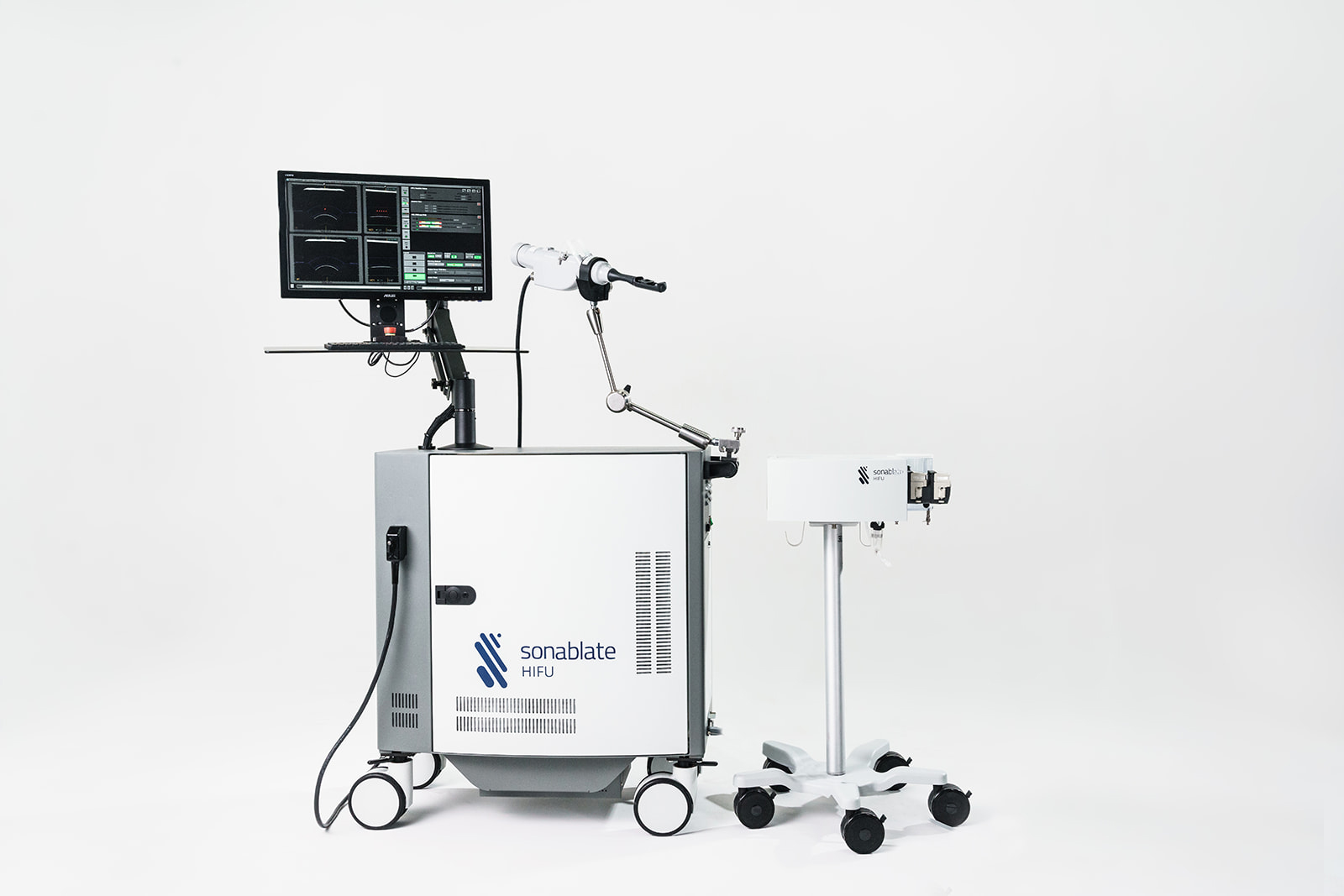In our Ask a Doc series, we sit down with physicians and other clinical experts, including those at Allegheny Health Network (AHN), for a chat on an important health topic. In this interview, we learn about prostate cancer screening and treatments from Dr. Ralph Miller, urologist at AHN.

According to the American Cancer Society, prostate cancer is the second most common type of cancer among men, affecting one in eight. Prostate cancer is often asymptomatic and is typically detected via a prostate-specific antigen (PSA) blood test and biopsy. Commonly diagnosed in men who are 65 or older, an individual's prostate cancer risk increases with age.
Prostate cancer treatment options have evolved over the last two decades, and the AHN urology team has been a leader in introducing the latest comprehensive treatments in western Pennsylvania. In honor of Prostate Cancer Awareness Month in September, I interviewed Dr. Ralph Miller, urologist at AHN. Here is what I learned.
Emily Mashore: How is prostate cancer first detected? Are there symptoms associated with it that men should be aware of?
Dr. Ralph Miller: Prostate cancer is usually detected early on during preventive screening. The purpose of screening is to catch cancer before a patient experiences any symptoms, and we have two types of tests to screen for prostate cancer.
The first is a prostate-specific antigen (PSA) blood test that measures the level of PSA in the blood. If those levels are elevated, that may be an indication of prostate cancer or another condition that can affect the prostate. The second test is a digital rectal examination, which allows us to feel for enlargement, nodules or abnormalities.
While there are no symptoms specific to prostate cancer, some patients may experience a rapid decline in the force of their urinary stream with the onset of prostate cancer.
Emily Mashore: When is screening recommended for patients?
Dr. Ralph Miller: According to the U.S. Preventive Services Task Force, it is recommended that men ages 55-69 undergo regular screenings. At AHN, we recommend that most men receive screenings starting at age 50.
Black men, however, are at the highest risk for being diagnosed with prostate cancer and should start prostate cancer screenings at age 40, along with men who have a family history of prostate cancer.
Emily Mashore: Why are men above the age of 70 discouraged from receiving regular screenings?
Dr. Ralph Miller: Men that we screen for prostate cancer should have a life expectancy of at least 10 to 15 more years. The reason we consider this factor is because prostate cancer is a slow-growing cancer, and with an early-stage diagnosis, a man can go several years before it becomes life-threatening.
Statistically, the ability to extend a man's longevity drops as he ages. Treatment for prostate cancer does come with risks, especially as a patient ages, so we wouldn't treat a patient if we didn't think it would impact their life expectancy or improve their quality of life.
Emily Mashore: If a patient's screening shows any indication of cancer, what is the next step?
Dr. Ralph Miller: The next step would be for us to take a prostate biopsy sample, at which we insert a needle through the skin and into the prostate to draw out samples of tissue. The entire procedure usually takes about 15 minutes.
Emily Mashore: Do you have patients that refuse a biopsy? What do you recommend for those who are hesitant?
Dr. Ralph Miller: We do run into scenarios at which a patient isn't interested in getting a biopsy. We understand the weight of being tested for cancer and the fears associated with it. In these cases, we offer alternatives like having the biopsy sample taken while a patient is sedated, or we simply continue monitoring the patient.
Most of the time, a patient will eventually go through with the biopsy, for the sake of their health and quality of life.

Emily Mashore: If a biopsy reveals prostate cancer and a patient is diagnosed, how do you determine the best treatment option for them?
Dr. Ralph Miller: The American Urological Association has official guidelines on how to treat different stages of prostate cancer. At AHN, we have a multidisciplinary team of experts in radiation options, as well as chemotherapy and immunotherapy, who collaborate with our urology team to create a unique care plan for each patient.
Generally, the first method to consider is active surveillance. For those with low-risk prostate cancer, we closely monitor and regularly follow up with screenings. For those with intermediate prostate cancer, which is usually localized and hasn't spread beyond the prostate, we use traditional therapy options like surgery or radiation. Someone with intermediate prostate cancer may be a candidate for our new high-intensity focused ultrasound (HIFU) therapy.
Patients with high-risk prostate cancer usually require surgery, radiation, medical therapies, or combinations of therapies. We offer minimally invasive treatment options for most patients that require surgery. With localized cancer, we often utilize our robotic surgery tools.
Emily Mashore: You mentioned that high-intensity focused ultrasound (HIFU) therapy is a newer treatment option for patients. Can you explain how it works?
Dr. Ralph Miller: We are proud to have the Sonablate® HIFU capability at AHN, becoming the first health care system in western Pennsylvania to offer this type of focal therapy to patients. HIFU treatment uses high-frequency ultrasound waves to target and destroy cancer cells in the prostate while protecting the surrounding tissue. This is performed while a patient is under general anesthesia, and we insert an ultrasound probe into the rectum to direct ultrasound waves at the cancerous tissue.
Most patients undergoing this therapy have low to intermediate risk prostate cancer. They are able to go home the same day as their procedure and fully recover in about five days. This treatment helps patients avoid the risks and side effects of traditional surgery and therapies.

In 2015, Sonablate® high intensity focused ultrasound (HIFU) became the first focused ultrasound device to be FDA approved for the ablation of prostate tissue.
Emily Mashore: In addition to this treatment, what other advances in care has the AHN Urology Department implemented in recent years?
Dr. Ralph Miller: We have several advanced treatment options for treating localized prostate cancer. Cryosurgery is a treatment option where we use a cryoprobe to freeze prostate tissue and destroy cancer cells. The cryoprobe pumps cold gas through the prostate until it reaches temperatures under 40°F, ultimately shrinking and killing cancer cells.
We also have prostate brachytherapy in which we implant radioactive seeds into the prostate to tackle the tumor without harming the rest of the body. External beam radiation therapy is another treatment option that uses high-energy radiation beams to kill cancer cells, now completed in just five treatment sessions, compared to 40 in the past.
A treatment option that we often utilize and see high success rates with is robotic prostatectomy, allowing us to perform robotic-assisted prostate surgery on an outpatient basis. This treatment is innovative, minimally invasive and allows patients to have less pain and blood loss, and shorter recovery times.
We perform prostatectomies using the da Vinci® Surgical System, a sophisticated robotic surgery system that allows us to operate on the prostate through small incisions and with enhanced vision, control and precision. In 2023, we first offered single-port prostatectomies, only requiring one or two incisions.
Emily Mashore: Are there any emerging developments in men's health that you are excited about?
Dr. Ralph Miller: Yes, we are currently exploring the adoption of Aquablation therapy, a treatment to cure benign prostatic hyperplasia (BPH), or a noncancerous condition that causes overgrowth of prostate tissue. This procedure involves a camera, ultrasound imaging and a computer-controlled waterjet to precisely remove prostate tissue.
This is another innovative care tactic for men's health that I hope to dive into to further benefit our patients at AHN.